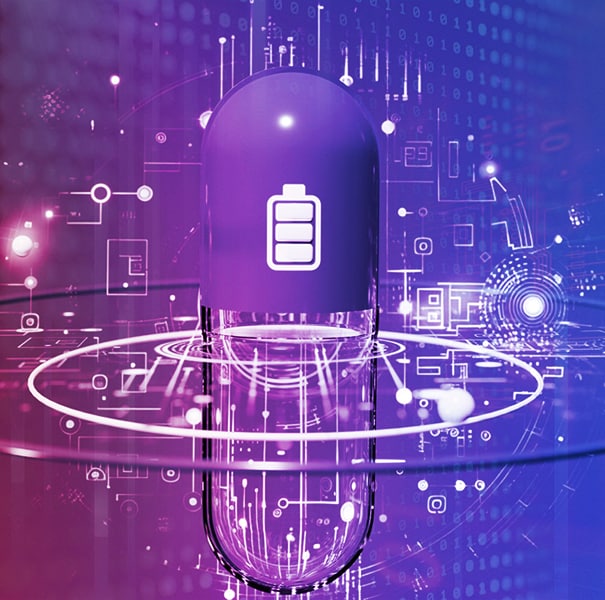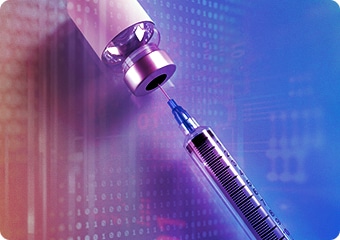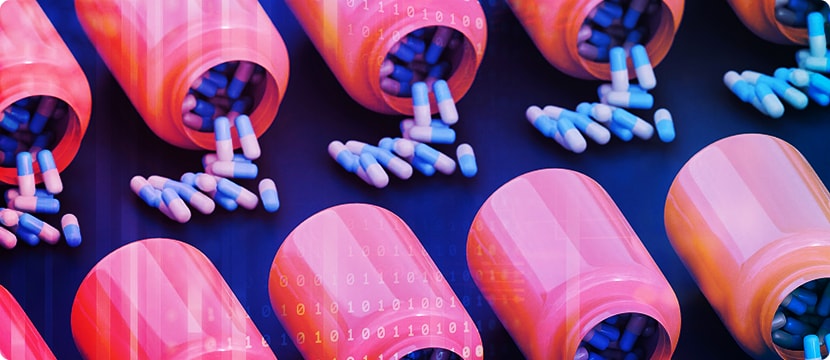

In the complex world of pharma, AI and machine learning are transforming the way we discover and develop drugs. From analyzing vast datasets to predicting drug efficacy and safety, AI is reducing the traditionally long and costly process of drug development.
Human bodies are complex, as are the diseases that affect them. Consequently, many diseases do not have a cure even today. While the reasons are many, one of the major bottlenecks is the expensive, drawn-out drug development process. Discovering and developing a drug can take up to 15 years of human effort and cost over $2.8 billion. It also has an overwhelming failure rate1. But does it have to be such a daunting task? With technology advancing at an unprecedented pace, we now have enough data and tools to do everything better. Finding better drugs faster that impact millions of lives should be the top priority of the tools we have today. Visionary pharmaceuticals and biotechnology companies understand this. They have digital teams to identify use cases that can have maximum impact in shrinking the timelines and increasing the precision at every step of the process.
A significant challenge for this innovation, however, has been regulatory compliance, but recent strides from the FDA has created new hope.

The Center for Drug Evaluation and Research (CDER) at FDA has undertaken the Framework for Regulatory Advanced Manufacturing Evaluation (FRAME) Initiative in collaboration with the Center for Biologics Evaluation and Research (CBER) and the Center for Devices and Radiological Health (CDRH).
FRAME focuses on developing a framework for AI-enabled development and manufacturing of pharmaceuticals. Regulatory oversight and a connected ecosystem will enable pharmaceutical manufacturers to modernize the technological infrastructure and integrate AI / ML models and analytical applications into core functions.
How exactly should R&D teams leverage AI in the drug discovery process? We discuss three focus areas that pose the touchest challenges in developing new treatements.
Drug design
Let’s dissect a typical drug discovery process. Millions of datapoints need to be analyzed to find potential drug compounds that might effectively treat diseases. Once a potential compound is identified, it has to be matched with a specific protein receptor– the right biological target for the compound to interact with. After mapping the compound with a protein, we must validate this pairing (to make sure it’s the right target) and optimize its structure. Determining the structure of just one such protein could take years of laboratory work.
Drug Screening
Deep learning models can also predict the properties –biological and biochemical activity, physicochemical properties, and toxicity – of these molecules by analyzing their structure. Researchers need this information to understand how a drug will behave in the body, screening out compounds that are not likely to succeed. This allows the R&D teams to focus and select the most promising compounds to be taken forward for development. It also allows the teams to optimize efficiency and safety features prior to the synthesis or production of the new drug molecule.
Drug Repurposing
While AI has already made its mark in small molecule discovery, it’s the large molecules like antibodies and proteins that make the pipeline in pharmaceuticals – the market is expected to grow to $3.2 trillion4 by 2030.
Scientists are now harnessing AI/ML capabilities to predict structures and functions of proteins, and in streamlining the process of designing both traditional drugs and advanced therapies like RNA-based vaccines. This more than just about bringing new drugs to market faster; it’s about repurposing existing ones for new uses.
AI is making this possible by identifying and classifying new targets for existing drugs and determining similarities between molecules. For instance, AI-based analysis of the toxicity of similar compounds improves safety while reusing a drug for a new therapeutic use.
Clearly, AI technologies create immense value in every stage of the drug discovery process. They’re making the process faster, finding new ways to use existing drugs, and helping ensure that these drugs are safe and effective.

Once a new drug is discovered, pharmaceutical manufacturers conduct extensive studies on new drugs, vaccines, and biologics to establish the effectiveness and safety of the treatments. They take a phased approach– Phase 1, Phase 2, and Phase 3 – with each phase having different objectives. After successfully completing the trials, they submit detailed reports to the FDA for review. Only after the FDA’s approval can they launch a drug into the market. This process can take several years to complete.
During the pandemic period, for instance. Moderna took just about 65 days to develop their mRNA vaccine. Clinical trials and authorization by the FDA, however, took an additional 270 days5. While the importance of safety is not up for discussion, we can certainly speed up the process to make the right treatment available at the right time.
- Digital Twins
AI brings another innovative application in drug development is the creation of digital twins. These are virtual replicas of patients designed to predict responses to treatments under various medical scenarios accurately. Digital twins facilitate a faster transition from early, small-scale tests to comprehensive Phase 3 clinical studies. They boost the speed, safety, coverage and predictability - Research Bias
AI also brings a strategic edge to clinical trials, optimizing resources by fine-tuning study protocols, size, and duration. It enhances the reliability and efficiency of these investigations, cutting down on research bias and enabling remote data collection through IoT devices. This not only allows for real-time health status analysis but also aids in reporting adverse reactions promptly. - Coverage
Biotechnology and pharma companies should recruit a diverse patient population to prove that a drug is safe and effective for its intended use. Clinical trial reports should demonstrate how the therapy affects patients across diverse demographic segments and medical conditions. AI-powered tools aid in participant enrolment and patient screening, ensuring a broad and representative sample for these trials. Algorithms assess electronic health records to identify the most appropriate patients for a study based on exhaustive trial criteria. - Compliance
Significantly, reliable data trails help enterprises address the stringent requirements for statutory approval. Digital documentation eliminates error-prone paperwork and minimizes administrative workloads while creating a comprehensive database of the design and clinical outcomes of each new drug. Further, automated data analysis accelerates the submission of new drug applications and enables regulatory teams to expedite review and approval.
Loved what you read?
Get practical thought leadership articles on AI and Automation delivered to your inbox


Loved what you read?
Get practical thought leadership articles on AI and Automation delivered to your inbox
AI-powered systems shorten the timelines for designing and delivering new chemical entities. In turn, it ensures economic viability for drug developers and efficient treatment for patients. Possibly, every pharma and biotech company realizes the importance and impact of AI. But barely 14%6 have successfully embedded digital technologies into their R&D workflows and that’s the more mature process. So the question is where should companies start? The first step must be aligning key stakeholders and experts and developing a comprehensive road map – digital transformation, talent strategy, partnerships, investments – to get a jumpstart in the right direction.
Disclaimer Any opinions, findings, and conclusions or recommendations expressed in this material are those of the author(s) and do not necessarily reflect the views of the respective institutions or funding agencies
- https://www.asbmb.org/asbmb-today/opinions/031222/90-of-drugs-fail-clinical-trials#:~:text=It%20takes%2010%20to%2015,to%20develop%20one%20successful%20drug
- https://www.fda.gov/news-events/fda-voices/fda-releases-two-discussion-papers-spur-conversation-about-artificial-intelligence-and-machine
- https://www.ipd.uw.edu/2021/07/rosettafold-accurate-protein-structure-prediction-accessible-to-all/
- https://www.einnews.com/pr_news/599925140/global-pharmaceuticals-market-projected-growth-until-2030
- https://asteriskmag.com/issues/04/from-warp-speed-to-100-days
- https://www.mckinsey.com/industries/life-sciences/our-insights/top-ten-observations-from-2022-in-life-sciences-digital-and-analytics




